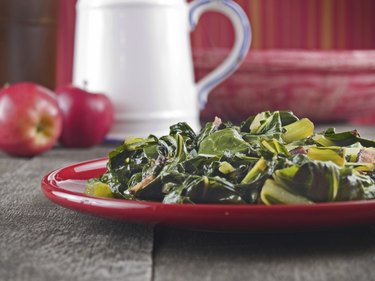
Some cuts of meat, like some actors, are destined for supporting roles. Lacking the glamor of sizzling steaks or juicy roasts, inelegant cuts such as pork neck bones are seldom at the center of a meal. Instead, these stubbornly tough and bony pieces are used to lend rich flavor and body to a variety of traditional slow-cooked meals. Like smoked hocks, smoked neck bones can provide the base flavor for rich soups, bean dishes or slow-cooked, Southern-style greens.
Neck-Bone Soup Broth
Video of the Day
Any number of soups from around the world rely on a piece of smoked pork for their base of flavor. Smoked hocks and ham bones are common choices, but the neck might just be the best of all. Its heavy pieces of bone, thick cords of connective tissue and dense muscle are all packed with natural collagen, which gives your broth a rich mouth-feel and body. Simmer the pork neck for hours with onions, celery or other aromatics to suit your taste, until the flesh is falling from the bones. Strain the broth and chill it, and then remove the hardened fat from the top. Pull the luscious neck meat from the bones, and use it in your soup or another dish.
Video of the Day
With Beans and Lentils
Legumes such as peas, beans and lentils are flavorful and superbly nutritious in their own right, but they have a remarkable affinity for pork flavor. Tucking a few pieces of neck bone into your favorite dish of lentils, black-eyed peas, navy beans, garbanzos or even slow-cooked green beans utterly transforms the end result. Your beans will absorb the rich, smoky pork flavor from the neck bones, while their collagen enriches and slightly thickens the broth. Shred the meat from the bones once it's tender, and either return it to the pot or reserve it for a second meal.
A Mess o' Greens
Sturdy greens -- from cabbage to collards and kale -- benefit from long, slow cooking, which breaks down their relatively tough fibers and leaves them meltingly tender. Adding the greens to a pot that already contains simmering smoked neck bones ups the ante, infusing the greens with flavor and their cooking liquid with rich body. That liquid, or "pot liquor," is a cherished side benefit. Mopping up the pot liquor with a piece of cornbread marks the end of a satisfying meal, and the leftovers are excellent for cooking rice or vegetables.
Choucroute Garnie
In the European tradition, smoked neck bones often accompany sauerkraut. The acidic tang and crunch of the pickled cabbage subsides to a smooth flavor and tender texture after long, slow cooking; again, the neck bones impart both richness and flavor. Deluxe versions of the dish -- "choucroute garnie," a French term -- generally also include caraway seeds or juniper berries, and several other kinds of fresh and smoked meats added throughout the cooking time.